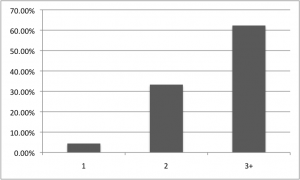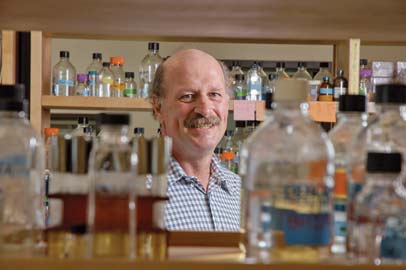Olympic ban a tight squeeze for Spandy: Vancouver street performer dances around city busking regulations
March 3, 2010 by Kim Ytsma · Leave a Comment
Standing in front of the Vancouver Art Gallery, Andy Rimer adjusts his tight yellow short-shorts, which he wears atop his custom-made, neon checkered spandex outfit.
“Today, I am wearing a luxurious one-piece,” said the 22-year-old, as he modeled his outfit with a laugh, pulling a pair of black goggles over his curly locks and placing his oldschool boom box on the sidewalk. The Andy Samberg look-alike spent a moment skipping through techno songs before bursting out onto the street and gyrating down the road.
He moon-walked, break-danced and freestyled down the pavement, and pedestrians couldn’t help but laugh. As Rimer danced circles around an unsuspecting businessman carrying a briefcase and shook his booty at a middle-aged man, an old woman on an electric scooter stopped to watch and smiled.
“I love getting people’s reactions and shocking people. I love bringing them out of their regular day,” said Rimer. “Whether they smile or they’re just stunned, I know they won’t forget what they just saw.”
His parents know him as Andy, but Rimer is better known as his alter-ego, Spandy Andy: Vancouver’s spandex-wearing break-dancer, who has dominated the street-performing scene since his first appearance at English Bay.
His slogan?
“Spandy Andy puts the mint in entertainment,” said Rimer, “and that’s fresh!”
After his audition on So You Think You Can Dance Canada was aired nation-wide, and he won the title of Colgate’s Freshest Dancer and $10,000, “Spandy” has returned to the streets of Vancouver to do what he loves best: make people smile. Even though many choose to shy away from his wild antics, Rimer doesn’t mind in the least: this is what he loves to do.
“For sure people ignore me,” said Rimer. “They’re scared of me, which is kind of funny since I’m a five-foot-nothing guy in spandex.”
Although the cold weather didn’t stop his performance today, the approaching Vancouver Olympics could. According to the City of Vancouver, buskers are not permitted anywhere near the Olympic venues during the 2010 games. A representative from the city’s busking department told the Chronicle that the ban around the Olympics was due to “security concerns,” something Rimer has a hard time understanding.
“Look at me,” said Rimer, looking down and laughing at his ridiculous outfit. “What is this short, goofy looking man in spandex going to do?”
The city wanted to make it clear that artists have the opportunity to perform in other areas of the city, as long as they have a permit and follow the city’s guidelines.
Within the past year, Rimer has fought many battles with city officials, including one over the volume of his boom box and another over where he can park his neon-green electric scooter, but this is by far his biggest battle. With recent changes to the regulations, Rimer could bunable to perform in public.
“We are not allowing any music amplification [including] batteryoperated or electric…no boom boxes,” said the city’s representative. That’s a change to the original “reasonable” volume control allowed last year.
The new restrictions and Olympic ban has forced Rimer to take “Spandy Andy” elsewhere, seeking out local community-building project “I Heart Van Art” to support his act. I Heart Van Art has partnered with the Yaletown Business Improvement association, according to Rimer, who said the association would be filling up the streets of Yaletown for a 17-day street event during the Olympics.
Rimer plans to apply as a performer at the event, but he also has a way of getting around the city’s bylaws, allowing “Spandy Andy” a chance at worldwide fame, as tourists from all over the world swarm the Vancouver Games.
“It creates complication when you put your hat out and ask for money, so if I don’t have a hat, I’m not technically a busker,” said Rimer. “Nobody can get mad at a random guy dancing in spandex. You just can’t be angry at that.”
As Rimer danced past a row of cars stopped at a traffic light near the Art Gallery and signalled for them to start dancing, a middle-aged man rolled down his window and began dancing behind the wheel. A huge smile came across Rimer’s face, as he danced with the man until the light turned green.
“Just wait for the Olympics,” said Rimer. “Without the hat, I’m going to be busting out of trees. You never know when Spandy Andy’s going to pop out of nowhere and surprise you.”
Believe it or not: The unexpected history of three Lower Mainland roads
January 14, 2010 by Mitch Thompson · Leave a Comment

Bill Purver, archivist for the City of Richmond, examines a statue of Minoru commissioned by the city to honour the popular racehorse.
An award-winning racehorse, a severed leg and a murderer are not typical inspirations for street names, unless you live in B.C.
Those three items are the basis of street names in Richmond, Surrey and Vancouver, and among the weirder stories collected by the cities’ archivists.
City archivists collect and record the histories of the various municipalities, and store it for later reference.
Melanie Hardbattle, an archivist with the City of Vancouver, said her job offers a necessary service to those in Vancouver.
“It’s very important for people to feel a connection to the past,†she said.
Many use the archival records to research city events, family lineage, even the history of their houses.
“We provide an important service to those people. If we didn’t have the records, we wouldn’t be able to provide that info,†she said.
Sometimes that provided info can get a little strange. Below are the three of the wildest stories behind street names.
Richmond – Minoru Boulevard
A quick Google Maps search for “Minoru†in Richmond gives about 500 results, covering one area of the map in little red dots. There’s Minoru Chapel, Minoru Place Senior’s Centre, Minoru Laser Dental, not to mention the actual boulevard itself. Minoru is everywhere.
“Most people think that Minoru is a Japanese name, and has something to do with the Japanese-Canadian community,†said Bill Purver, a Richmond archivist. Purver explained that many Japanese immigrants came to the Steveston area in the 1800s to seek out lives as fishermen.
But the popular name has absolutely nothing to do with the Japanese-Canadian community.
The boulevard et al are actually named after the thoroughbred horse Minoru, who, in 1909, was the first horse to win two classic races, the 2,000 Guineas and the Derby, while wearing a reigning monarch’s colours.
In August of that same year, construction on a Richmond racetrack finished. It was christened Minoru Park in honour of the record-holding horse.
The racetrack was a hit, with 7,000 spectators attending the first day, according to a Richmond News feature. The track closed in 1941, but the name’s popularity had spread, leading to the many things Minoru.
Surrey – Hall’s Prairie Way
It was once the best horse-and-carriage road south, with an infamous claim to fame.
Hall’s Prairie Way, now 184th Street, may be the only British Columbia street named for a murderer.
In 1845, Sam Hall and his First Nation’s wife were the first to settle the southeast Surrey district.
Soon after, Hall killed his wife. He later died in prison.
When the next wave of settlers came they called the place Hall’s Prairie, after the homicidal husband.
“Only a mouldering cabin and a legend remained,†wrote Fern Treleaven in his 1981 book Rivers, Roads and Railways.
He also wrote that the children of the new settlers feared the old Hall cabin, believing it to be haunted.
Vancouver – Leg-in-Boot Square
Since late 2007, B.C. residents have been living with a strange occurrence: severed feet washing up on shore.
These feet are unidentifiable and unclaimed, but also not a new thing. This has happened once before.
In 1887, local police found a knee-high boot, complete with severed leg, in the forests of False Creek.
The police placed the limb outside the station, hoping someone would claim it, according to Elizabeth Walker’s Street Names of Vancouver. No one did.
Stuart Cumberland, a 19th-century writer, mentions the boot in his 1887 book The Queen’s Highway.
“Just before I visited Vancouver, a man had mysteriously disappeared; and, on the day of my arrival, a top-boot, containing a foot and portion of the leg, had been found in the forest of False Creek. This, it was surmised, was all that remained of the missing man, a cougar having disposed of the rest.â€
The forested area is long gone, but the story lives on. In a 1976 act, the city named the False Creek location Leg-in-Boot Square.
Sidebar:
If you’re looking for a perfect Christmas present, why not get something truly original: a street named after the recipient. Vancouver’s street-naming committee receives about half-a-dozen letters a year from Vancouverites putting forward the names of relatives and major contributors to the city’s development.
Nominations run the gamut from someone’s great grandfather to the recently deceased Jack Poole, former VANOC president.
“We maintain a fairly extensive list of people who have been nominated,†said Marg Coulson, acting city clerk and chair of the committee. When a name comes before the panel, an archivist researches it, determining the nominee’s contributions to the city. “We really don’t want to be too restrictive, because people make contributions in different ways,†said Coulson.
When the merits of the name are proven, the name gets shortlisted. The list has just over 100 names on it, said Coulson.
If a street is created and a name required, the committee peruses the list to see which fits best, usually someone from the related area. A recommendation is then made to city council. The need for a name is rare, as Vancouver has very little in the way of new developments. The panel usually receives only one request a year.
“One thing I should say is that we do not consider people who are alive,†said Coulson, which could create a slight set-back for those considering self-nomination.
“We’ll have to kill you and then we can consider you,†she said, laughing.
Kwantlen University by the numbers: A calculated look at our school’s student demographics
January 14, 2010 by Mitch Thompson · Leave a Comment
By Jacob Zinn & Mitch Thompson
To better understand how the generational groups at Kwantlen work, the Chronicle polled a sample of students from three campuses: Surrey, Richmond and Langley.
The students were asked what year they were born, how many computers they own, if they have a Facebook page and whether or not they agreed with the generational values usually associated with people their age.
They were then given a five-point history quiz in which major events were named. Students had to give a basic description of 9/11, the Challenger shuttle disaster, JFK’s assassination, knowledge of the Berlin Wall and the bombing of Pearl Harbour.
The following graphs are the compiled results.

First music format purchase - Generation Y

First music format purchase - Generation Z

Facebook page - Generation Y

Facebook page - Generation Z

Number of computers owned - Generation Y

Number of computers owned - Generation Z

Agreement with generational characteristics - Generation Y

Agreement with generational characteristics - Generation Z

Percentage of correct answers to historical quiz - Generation Y

Percentage of correct answers to historical quiz - Generation Z
Students are learning more, but in danger of info overload
January 14, 2010 by Mitch Thompson · Leave a Comment

The overall population breakdown of Kwantlen Polytechnic University, based on age.
Almost half of Kwantlen students are members of Generations Y and Z, according to figures from the Institutional Analysis and Planning department, and were born into a world of personal computers and an explosion of information.
Generation Y includes people born between 1980 and 1989; Generation Z is those born in 1990 and subsequent years. Student records show that 48.8 per cent of Kwantlen students were born between 1988 and 1992.
The Y and Z designations came from a need for a distinction between the Baby Boomers, who were born after World War Two, and their children, who were born between 1965 and 1980. Those children have been called the “after-boomers.â€
Canadian author Douglas Coupland coined the phrase Generation X in his 1991 novel Generation X: Tales for an Accelerated Culture. He believed the title signified the seemingly contradictory ways of post baby-boom society.
The name caught on,and the Y and Z labels followed.
According to an article on About. com, a New York Times-run website, Gen-Yers value family time and teamwork. Generation Z, however, is more individualistic and puts less stock in family values, according to an article in Australia’s Herald Sun.
But there is one overarching value that the generations share.
“The main value, given their age, is probably a thirst for knowledge and looking for means of meaningful self-expression,†said Peter Clayton, a Kwantlen instructor whose courses focus on media and sociology.
This need to know manifests itself in the widespread use of the Internet to discover information and communicate ideas to others.
“The more serious-minded of them spend an enormous amount of time online in the quest for knowledge,†said Clayton.
The older ways of researching, using libraries and books, are slowly being phased out in favour of websites such as Wikipedia or Google.
It’s a change that allows them to learn while delivering the content in a way that is culturally relevant to them, explained Clayton.
However, this cultural inclination towards technology has created never-before-seen consequences for those of Generations Y and Z.
“The downside of all the information technology is that, as far as
leisure time is concerned, people spend more time on their own,†said Clayton.
Generations Y and Z are characterized by physical isolation.
Though they may be talking to friends online, they are still alone at a computer, which can have a negative effect on how they socialize in public.
“On one hand [their culture] encourages them to be more outward-looking,†said Clayton. “But on the other hand, it encourages them to be more isolated and inward-looking.â€
As well, constant access to the Internet has created two generations that suffer from information overload, Clayton said.
“They are probably a lot more stressed out than they realize,†he said. The two generations have become walking dichotomies, Clayton believes, as they want to learn as much as possible, but suffer from extreme information overload.
A thrift-store romance: How to impress the other gender when your budget is slender
January 13, 2010 by Mitch Thompson · Leave a Comment
The art of wooing can be expensive, especially for a poor university student, but creativity and a little pocket change can go a long way.
According to Sheree Morgan, a Vancouver-based professional matchmaker, the best place to start looking for value dates is away from screens or dinner tables.
“The best place for low-budget ideas is outdoors,†Morgan said.
With the large number of walking paths, hiking trails and parks in the Lower Mainland, there is something for all fitness levels.
Remembering your date’s physical prowess is important, as Soraya Raiszadeh, a Kwantlen student, knows well.
The thrifty outdoor excursion Raiszadeh went on included the infamous Grouse Grind.
“I wouldn’t say it was the best way to go on a date,†she joked.
Raiszadeh is one of 13 Kwantlen students asked by the Chronicle about the cheapest, most effective date they had been on. For the purpose of the poll, “effective†means that it lead to other dates, or was enjoyed by both parties.
Dana Stasyk, a first-year Public Relations student, was also courted outdoors. She was in Australia and, met a man named Pok, who took her for a stroll on the beach. “He had laid down a picnic at the end of the walk,†said Stasyk. “It was very sweet.â€
Romantic as woodland walks can be, Morgan does have one important tip. “Make sure you stick to the paths,†she cautioned. “It really kills the moment if you have to be rescued. Probably not a great way to end the date.â€
Going outside is one way that dates can be cost-efficient. The other involves a bit more inventiveness.
“Women love it if you’re a little bit creative,†said Morgan.
She used a past date she had been on to emphasize her point. “After a fresh snowfall, dress up really warm, take a thermos of hot chocolate and go to Stanley Park. I’d never done it before, and it’s probably one of the most wonderful things I’ve ever done,†she said. “It didn’t cost any money, it just took a little bit of thought.â€
Kaitlyn Cook, one of the interviewed Kwantlen students, also enjoyed a date that was simple, but memorable. Her date took her skating, but was absolutely awful at it. Luckily, Cook used to figure skate and they spent the date with her teaching him. “I don’t know, maybe he was faking, but it still made me feel special,†she said.
In fact, almost all of the students polled enjoyed the simple dates as much or more than the most expensive ones they had ever been on.
Ryan Cardoz, a business student, once took his date to Costco for hot dogs. The whole meal cost him a wallet-destroying $3.20.
“It was pretty effective,†Cardoz said. “We were both poor at the time.â€
The date was so good, he ranked it as high as the $240 meal at a downtown restaurant to which he later took the same woman.
Echoing his statement was George Pauol, a psychology major, who felt that the day trip he took with his girlfriend to Victoria was less enjoyable than just walking around the mall with her. He said that because of all the tourist attractions, they were both distracted and there was less time for conversation.
For many of those polled, good conversation with a person who would listen and make them laugh was essential to ongoing interest.
“Be very talkative, because I am a chatterbox,†said Rasizedah.
“As long as we can talk without feeling awkward, it’s cool,†said Alvin Denbock, a business student.
“If she’s interested in me, it makes her seem interesting,†said Cardoz.
“Make me laugh and you’ll get a shot. Don’t make me laugh, and you’ll never see me again,†said Cook.
Can several dollars worth of hot dogs and good conversation really be the Holy Grail of thrifty dating?
Morgan, the matchmaker whose focus is on finding clients a single, compatible match, agrees with the conversation part. “Be as positive as possible. Make it fun. We all want to be around somebody who is confident,†she said.
According to one of the polled students, it’s not about the content of the date, but the quality of the person next to you.
Anatomy of a virus: A biological breakdown of H1N1
January 13, 2010 by Mitch Thompson · Leave a Comment

File Photo of Dr. Hancock (Courtesy of UBC Media Services)
Strange mutations, odd biological behaviour and the potential to become more deadly have catapulted H1N1, better-known as swine flu, into the scientific limelight.
With the threat of a more deadly version of the virus on the horizon, scientists are trying to understand how this virus came to be, and what it will become.
A team of UBC researchers has made interesting discoveries about H1N1 by studying a different virus: the one that causes avian flu.
The team has been studying how avian flu causes inflammation, and compared it with similar viruses, including H1N1.
“Intrinsically, swine flu doesn’t have the ability to cause inflammation as strong as avian flu,†explained UBC microbiology professor Bob Hancock.
Hancock described H1N1 as “somewhat less harmful and lethal than even the normal seasonal influenzas usually are.â€
However, the British Columbia Centre for Disease Control reports five deaths related to swine flu.
The cause of such deaths could be revealed by research Hancock’s team is doing into systemic inflammation.
“[The viruses] have on them… molecules that are recognized as ‘foreign’ by receptors inside cells, which turns on the inflammatory process,†said Hancock.
This process is a natural defense against these foreign objects, but the trouble comes when flu virus gets into the lungs. The inflammation that occurs can spell disaster if it continues for too long.
“Inflammation in the lungs… causes a lot of fluids to come into the lungs. People literally drown from their own fluids,†said Hancock.
In addition, the virus can worsen secondary infections and cause death, as shown by the 1918 Spanish Flu, which was also a form of H1N1. More than 20 million people died in that outbreak, according to the World Health Organization. Antibiotics had not yet been invented.
Seniors with age-related, health complications are vulnerable to flu-induced complications, but that may not be the case with H1N1.
“Elderly people have seen an H1N1 type virus before. I think the
last outbreak was in the ’70s,†said Hancock. “They tend to have some immunity to this virus…balanc[ing] off the sort of increased susceptibility.â€
A young, healthy person’s lack of existing antibodies may put them at higher risk than someone who was exposed in the past.
However, past exposure and the resulting antibodies don’t necessarily rule out infection, as the swine flu of 1918 and 1970 was not exactly the same as the swine flu of today.
“Flu has the ability to undergo a variety of processes that can change it…so that our body no longer recognizes it,†explained Hancock.
These changes of form are the reason people must be re-immunized every year.
Scientists use the system of H1N1 to categorize various flu strains by the sequence of hemagglutinin (H), the molecule that binds the virus to cells, and neuraminidase (N), the molecule that cuts free freshly made virus cells.
Some strains have similar sequences (swine flu is H1N1, avian flu is H5N1), so they are grouped together although they are biologically different.
The viruses categorized as influenza A, of which swine flu is one, generally have a hard time infecting humans, but H1N1 found a way to adapt itself to allow easy human-tohuman transmission.
“What it looks like is a farm worker managed to acquire two strains of influenza from pigs, and they went through a process known as reassortment,†said Hancock.
The two viruses swapped bits of each other until a new one was eventually created.
The union produced a certain strain that is easily transmitted between human beings.
“It’s really new, and people don’t really have an existing immunity,†he said. “There’s substantial concern that it could mutate in a way that would allow it to become more deadly.â€
Steveston losing small-town feeling?
January 13, 2010 by Katie Lawrence · Leave a Comment

Moncton Street in Steveston in 1906. (Photo courtesy of the Richmond Archives)
The fishers have laid out their catches and are selling them to the locals walking the Steveston docks on a Saturday morning. Many kinds of fish and seafood, including crab, prawns and halibut, are on display, along with the boats that crowd Fisherman’s Wharf. This has been a source of income for seamen since Steveston was first founded as a fish- ing village in 1890. There is a smalltown feeling to it all.
Turn around though, and you might get a different feeling. The other side of the wharf is loaded with restaurants and shops for the tourists. Walk a block to the east and you see three coffee houses — Blenz, Starbucks and Waves — all within one glance. A block north, there’s a McDonald’s nestled into the old train-station building across from Steveston Park and Community Centre. With more commercial development moving into the Richmond subdivision, there are those who think the sense of community in Steveston is getting lost. Given that it’s one of Richmond’s first neighbourhoods, some feel that the “gritty†feel of Steveston should be a priority.
Dave’s Fish and Chips’ manager Bryan Scott is one of them. “[The development] is becoming a little
too much. The way it’s being built is taking away from the overall appearance of Steveston,†Scott said.

Present-day Moncton Street in Steveston. (Katie Lawrence Photo)
“There were lots of older buildings that were one storey and and now there are two-storey buildings with the apartment above. It’s becoming bigger than it should,†added Scott, who has worked at Dave’s for 17 years.
Dave’s has been in Steveston since 1978 and although it’s moved a couple of times, business has been pretty solid, even after McDonald’s opened just down the road.
Scott said that McDonald’s moved in at a time when a lot of apartments were being built and more people started to live in Steveston.
Development might not be that bad, said Terry Crowe, manager of the Policy Planning Division for the City of Richmond and member of the Richmond Heritage Commission.
Crowe said that of the 90 buildings in Steveston Village, only 17 are protected by the Steveston Area Plan, a heritage-conservation strategy. The other 73 buildings can be demolished or changed in any way. The 17 protected buildings cannot be knocked down and the exteriors must comply with the 14 federal heritage standards set by Parks Canada.
According to the Parks Canada Standards and Guidelines Report, some of those standards are:
- Conserve the heritage value of a historic place. Do not remove, replace or substantially alter its intact or repairable character-defining elements. Do not move a part of a historic place if its current location is a character-defining element.
- Conserve changes to a historic place which, over time, have become character-defining elements in their own right.
- Find a use for a historic place that requires minimal or no change to its character-defining elements. The exteriors of the buildings must stay the same, but the interiors can be altered.
“We’re just interested in the exteriors of the buildings. We don’t care what is done with the insides, so that gives the village a lot of flexibility,†Crowe said.
Dave’s Fish and Chips is one of the protected buildings. The structure itself is made up of brick and wood with two bright-blue doors and big bay windows facing Moncton Street. On the east side of the building, there’s a take-out section and some picnic benches.
Another one of the 17 heritage buildings is the post office/museum, which looks like an old house sitting on the corner of Moncton and First Streets. It was Steveston’s first bank, built in 1905. The top half of the building is painted burnt orange, the bottom is a creamy yellow. The house exterior is accented by thick, white trim. There is a park in the back that is shaded by leafy trees in the summer. The outside of the building has been preserved to match the federal heritage standards, but the inside is a functioning post office and museum dedicated to Steveston’s history.
Crowe also explained that some of the 73 buildings not protected by the Steveston Area Plan are privately owned, so the City of Richmond cannot decide what businesses can move into that space.
“It’s like when an apartment is built. The city cannot pick and choose who the tenants are,†said Crowe. “The City does not interfere with privately leased spaces. I get that there’s some anti-McDonald’s opinions and all that, but the City has no control over it. We do not deal with occupancy.â€
Crowe said he feels that as long as the Steveston Area Plan and federal heritage standards are followed, the new commercial development doesn’t affect the small-town feel of Steveston at all.
He said that people want someplace to live, work and play in a community and because of that, both commercial development and heritage buildings can co-exist in Steveston.
“You could create a Disneyland in there,†he said, “but no one wants it to go that far.â€
Increasing number of papa bears stay in the den
January 13, 2010 by Katie Lawrence · 1 Comment
There’s an old stereotype of the family: Mom stays home with the kids while dad goes off to work to support his wife and children.
That stereotype doesn’t necessarily apply anymore. More dads are staying home while moms are the family breadwinners, says Kwantlen sociology instructor Seema Ahluwalia.
Those are fathers like Chad Skelton, reporter for the Vancouver Sun and current stay-at-home father. He’s in the middle of an unpaid leave of absence from his job to stay home with his 18-month-old son.
“I’ve actually enjoyed it a lot more than I thought I would,†said Skelton. “I was worried that as the year got closer, that I might find it boring, and there are moments, but I really enjoy it a lot.â€
Skelton, 33, has been home with his son since March and although he loves it, his role at home still isn’t understood by some older men.
“People my age are completely fine with it, but people, especially older men, from my parents’ generation, assume that it would be boring to stay home for a year,†he said. “They always ask me what I do with my time.â€
His response is that he takes his son out to places in the city such as
the aquarium or the park on nice days. And his son has two naps a day, giving Skelton some time to work on the weekly parenting column that he writes for the Sun or to mark papers from the class he teaches one night a week.
Not all men take to stay-at-home parenting like Skelton does, though.
“I’ve got a friend who works at one of the police departments and under his contract, he can take three months off once he has a kid, but he’s not sure if he’s going to because he might get teased.â€
Ahluwalia, who has been teaching for 10 years, finds the worries of a stay-at-home dad not being a “real man†common.
“We hear a lot from stay-at-home dads about the stereotype of not being treated like a real man because they’re not getting a real job,†she said.
“Men still feel that pressure about not being the breadwinner. It’s one of those stereotypes that chips away at their masculinity.â€
Ahluwalia said that after 40 years of cultural changes, before which a father as the stay-at-home parent was “utterly inconceivable,†roles have changed into more of a whocan-actually-do-it-right-now style of parenting.
“With the economy becoming more and more expensive over the years, that has forced the ways of parenting to change. Sometimes, the woman has a better job and, for that family, it might be a better solution with the dad staying home,†said Ahluawalia.
Ahluwalia is a working mother and her husband stays at home with their child for most of the day. She and her husband are known as “radical unschoolers,†which means they don’t send their child to public school. They let their son “learn about the world around him in ways that engage him.â€
Her husband, a ceremonial leader in his Lakota First Nation, takes their seven-year-old son around to all his lessons, which include piano, horseback riding and art.
“My husband and I see ourselves less as teachers and more like facilitators. Our son wouldn’t be able to have the schooling experience he’s having if my husband didn’t stay at home,†she said.
Statistics show that stay-at-home dads are becoming more common in Canada.
“In 1976, there were 36,000, whereas now, there are 77,000,†said Ahluwalia.
With more women getting into the workforce, she said, it’s not as easy for a man to graduate from school, get the ideal job and live the stereotype.
Extreme measures to avoid extreme flu
January 13, 2010 by Katie Lawrence · Leave a Comment

In this photo illustration, Milana Jasper (left) and Heather Tijman are demonstrating one method of preventing the spread of the H1N1 virus by wearing a mask when being cared for.
How far would you go to avoid getting the H1N1 virus, more commonly known as swine flu?
Some countries have been taking extreme measures against the virus, but local health authorities say that’s not necessary.
• In April, Egypt ordered the slaughter of the country’s 300,000 pigs, believing it would calm people because pigs are seen as unclean, reported the Sydney Morning Herald.
• The majority of the Japanese public has worn masks since May to avoid the H1N1 virus, thousands of schools were closed and testing centres were flood with people, reported Foreign Policy magazine. Also, Japanese politicians have announced that they will not shake hands with anyone until the H1N1 scare has died down.
• The Big Gig Weekend festival at the Royal Bath and West Showground in Britain has taken out insurance of up to one million pounds for performers Katherine Jenkins, James Morrison, Boyzone and Diversity, in case they come down with the virus, reported the London Telegraph.
• According to l’Agence France-Presse (AFP), when a case of H1N1 was confirmed in a passenger coming from Mexico, Hong Kong quarantined the hotel where the traveller was staying, and tired to track down all the passengers who were on the plane with the man.
• China was prepared to close schools and convert a holiday camp into a quarantine centre when the virus hit the country, reported AFP.
• The Local (Sweden) reported that some Swedish churches have started serving fortified wine at communion, hoping that it will reduce the risk of the spread of H1N1, while others have advised Swedish faithful not to attend communion.
But all the action that needs to be taken is being prepared, said Roland Guasparini, the Chief Medical Officer at the Fraser Health Institute.
“I’ve heard of people avoiding air travel and keeping kids out of their activities, but there’s no need to do anything much more than that,†said Guasparini. “What you need to do is stay healthy, sleep, eat well, get some exercise and keep away from sickies.
“If you do have to look after someone, put a mask on them, so that they’re not coughing all over you, and then wash your hands thoroughly or use an alcohol-based hand sanitizer.â€
Though it’s a bit of an odd idea, Guasparini said that the Japanese politicians may be on to something by not shaking anyone’s hand.
He said that if you shake hands with somone with the virus, and then eat something without washing your hands, you could get the virus. Guasparini thinks that the ru- mour of how H1N1 is contracted – humans getting it from pigs – has been put to rest because of media coverage. He said that it’s actually the other way around: humans give H1N1 to pigs or to other humans.
“[The disease] is passed on per- son-to-person through the eyes, nose and mouth, usually through hand-to-hand contact with objects and then touching your face, where the cells attach to the inside of your nose and/or mouth.â€
Richmond steps up and rocks out: Community centres expand the music scene with local band nights
January 13, 2010 by Katie Lawrence · Leave a Comment

Venice Queen lead singer Ryan Bloomfield rocks out at one of their shows downtown.
Everybody loves to see their favourite stars perform, but nobody likes the empty wallet when the show is over.
For example, tickets to the Oct. 23 Rascal Flatts concert cost at least $85 for a decent seat, which for some is too much for four hours of music.
A way to remedy that is to see the talent showcased a couple nights a month at Richmond community centres, for $5 or less.
Youth programs at both Steveston Community Centre (SCC) and South Arm Community Centre (SACC) run the band nights on Fridays during the Night Shift program, a weekly youth hangout night and now Cambie Community Centre is getting in on the act.
The Cambie centre, at the corner of Cambie and Jacombs roads in Richmond, is hosting Richmond based band Venice Queen’s first all-ages show on Oct. 23. Opening for them will be local youth bands Ill and Fallen, and The Chase. All three up-and-coming bands play serious rock music, and the Cambie Night Shift coordinator is excited that they’re playing at the community centre’s first ever band night.
“We’re just beginning to explore the musical side of things at Cambie,” said Brandon Bloomfield. “If this night goes well, we plan on having more.”
Venice Queen is one of the winners of the 2009 Vancouver Seeds competition, held by The Fox radio station for indie bands. The band has also played a number of shows downtown, but wanted to become better known in its hometown, so agreed to headline Cambie’s band night, which has a $5 cover charge.
Venice Queen has also played at South Arm Community Centre, which, along with Steveston Community Centre, has regular shows featuring high-school-aged and young adult bands.
Alvin Li, a Steveston Community Centre youth development worker, said that the band nights are more about the kids and their music than making money..
“It’s the chance to give youth in the area an opportunity to play and show their talents,” said Li. “We rarely ask for more than $2, sometimes it’s free [to get in] or… we ask for clothes during the winter to give to charity.”
SCC presents five or six acts a night, consisting of acoustic music with some rock and alternative thrown in. Li said they also want to expand into hip hop.
Most of the youth-oriented events at Steveston, including band nights, are “run by youth for youth,” said Li. He also said it’s a chance for SWAT, Steveston with Active Teens program, to learn how to organize events and members to develop leadership qualities.
Band nights at South Arm Community Centre are also run mainly by its youth group, Mosaic, and organized with the help of Andy Roy, a youth worker.
SACC has a band night once a month, featuring three or four local bands who play some metal, screamo, rock and alternative music, with a $5 cover charge. The next show at SACC is Nov. 13; the bands haven’t been announced yet.


